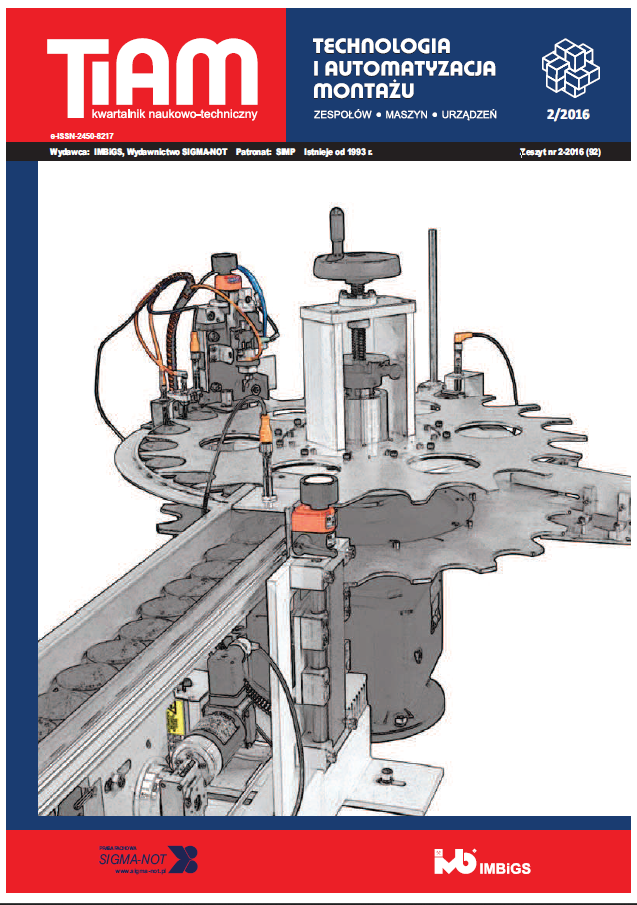Abstract
Friction stir welding (FSW) is one of the most modern technology of joining metals and their alloys in solid state. The possibility of joining elements of aluminum alloys makes it possible to use this method in the production of aircraft structures. This technology provides a reduction of labor consumption, cost and weight of structures, while maintaining comparable or better strength properties as compared to conventional methods of joining. Quality assurance of joining requires selection of the optimal process parameters such as tool rotational speed and feed rate. The paper presents the results of the welding process of 2024-T3 aluminum alloy sheet with a thickness of 1 mm carried out in accordance with the study plan PS / DK32. Welding tests were conducted on a universal vertical milling machine, and strength tests included static tensile test. In the final part of the article the analysis and interpretation of research results were performed.
This is an Open Access article distributed under the terms of the Creative Commons Attribution License CC BY 4.0 (https://creativecommons.org/licenses/by/4.0/)
References
Mishra R.S. 2003. “Friction Stir Processing Technologies”. Advanced Materials&Processes.
Pietras A., B. Rams, A. Węglowska. 2007. „Zgrzewanie tarciowe metod FSW stopów aluminium serii 6000”. Wydawnictwo Archiwum Technologii Maszyn i Automatyzacji, vol. 27 (1).
Hattingh D.G., C. Blignault, T.I. Niekerk, M.N. James. 2008. “Characterization of the influences of FSW tool geometry on welding forces and weld tensile strength using an instrumented tool”. Elsevier Journal of Materials Processing Technology (203): 46–57.
Giraud L. et. al. 2016. “Investigation into the dissimilar friction stir welding of AA7020-T651 and AA6060-T6”. Journal of Materials Processing Technology.
Yu Ch. et al. 2015. “Effect of welding heat input and post-welded heat treatment on hardness of stir zone for friction stir-welded 2024-T3 aluminum alloy”. Trans. Nonferrous Met. Soc. China (25): 25242532.
Seetharaman R., V. Ravisankar, V. Balasubramanian. 2015. “Corrosion performance of friction stir welded AA2024 aluminium alloy under salt fog conditions”. Trans. Nonferrous Met. Soc. China (25): 1427-1438.
Sadeesh P. et. al. 2014. “Studies on friction stir welding of AA 2024 and AA 6061 dissimilar metals”. Procedia Engineering (75): 145–149.
Amancio-Filho S.T. et. al. 2008. “Preliminary study on the microstructure and mechanical properties of dissimilar friction stir welds in aircraft aluminium alloys 2024-T351 and 6056-T4”. Journal of materials processing technology (206): 132–142.
Radisavljevic I. et. al. 2013. “Influence of FSW parameters on formation quality and mechanical properties of Al 2024-T351 butt welded joints”. Trans. Nonferrous Met. Soc. China (23): 3525–3539.
Yazdipour A., A. Heidarzadeh. 2016. “Effect of friction stir welding on microstructure and mechanical properties of dissimilar Al 5083-H321 and 316L stainless steel alloy joints”. Journal of Alloys and Compounds (680): 595–603.
Kocada D., A. Górka. 2010. „Nowe technologie łączenia tarciowego metali”. Biuletyn WAT (2), vol. LIX.
Korzyński M. 2006. „Metodyka eksperymentu”. Warszawa: Wydawnictwa Naukowo-Techniczne.
Kudła K., K. Wojsyk, Z. Kucharczyk. 2013. |Własności zakładkowych złączy spajanych metodą zgrzewania tarciowego z przemieszaniem (FSW – Friction Stir Welding)”. Obróbka Plastyczna Metali (3), vol. XXIV.
Balawender T., R.E. Śliwa, T. Gałczyński. 2014. „Zgrzewanie tarciowe blach ze stopu aluminium 2024”. Hutnik-WH t.81 (7): 450–455.

